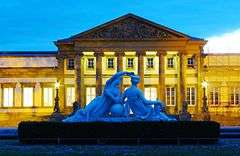Rosenstein Castle
| Rosenstein Castle | |
|---|---|
| Schloss Rosenstein | |
 View at Night | |
 | |
| General information | |
| Status | Restored |
| Type | Palace |
| Architectural style | Classical |
| Location | Rosenstein Park |
| Town or city | Bad Cannstatt |
| Country | Germany |
| Coordinates | 48°48′3.6″N 9°12′21.6″E / 48.801000°N 9.206000°ECoordinates: 48°48′3.6″N 9°12′21.6″E / 48.801000°N 9.206000°E |
| Elevation | 245 m (804 ft) |
| Groundbreaking | 1824 |
| Construction started | 1824 |
| Completed | 1829 |
| Renovated |
1950-1960 1990-1992 |
| Demolished | 1944 |
| Client | State Museum of Natural History Stuttgart |
| Owner | State Museum of Natural History Stuttgart |
| Dimensions | |
| Diameter | 75 m × 47 m (246 ft × 154 ft) |
| Technical details | |
| Floor area | 3,235 m2 (34,820 sq ft) |
| Design and construction | |
| Architect | Giovanni Salucci |
| Main contractor | King Wilhelm I |
Rosenstein Castle, in Bad Cannstatt's Rosenstein Park in Stuttgart, Germany, was the summer palace designed in the classical style by the architect and court builder Giovanni Salucci (1769–1845) between 1822 and 1830 for King Wilhelm I. of Württemberg.
The palace stands on a height overlooking the Neckar river valley. Formerly called the Kahlenstein (literally 'bald rock', because it was bare of trees), the hill was renamed Rosenstein ('rose rock'), and a rose garden was planted to the south-east of the palace.
Today, Schloss Rosenstein houses that part of State Museum of Natural History Stuttgart (SMNS) dealing with extant lifeforms.
|
This article is issued from Wikipedia - version of the Tuesday, December 15, 2015. The text is available under the Creative Commons Attribution/Share Alike but additional terms may apply for the media files.